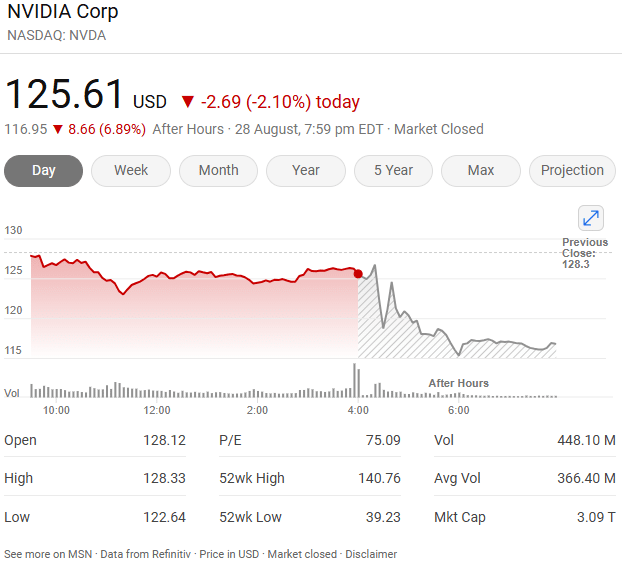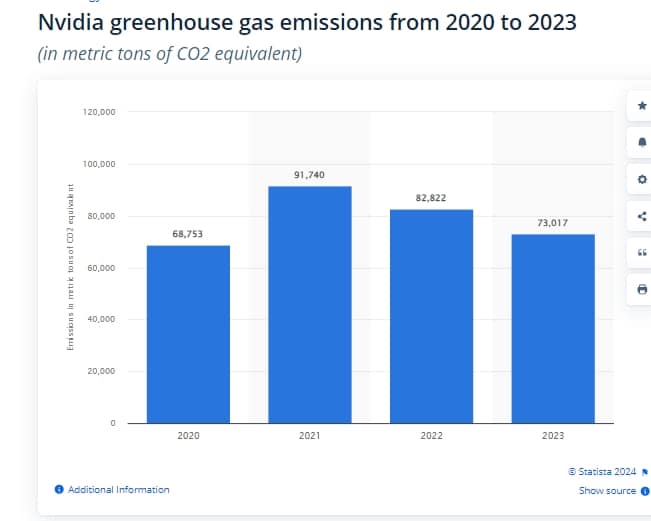NVIDIA had an impressive second quarter, surpassing market expectations with strong revenue growth and solid earnings. Despite these achievements, the company’s shares unexpectedly dipped. On the positive side, the chip giant successfully reduced its emissions and is aiming to incorporate sustainable solutions throughout its operations.
NVIDIA’s Impressive Q2 Results Indicate 360 Degree Growth
NVIDIA reported a remarkable $30.0 billion in revenue for the second quarter ending July 28, 2024. This marked a 15% increase from the previous quarter and a staggering 122% jump from last year.
The company gave back $15.4 billion to shareholders in the first half of fiscal 2025 through buying back shares and paying dividends. The company still has $7.5 billion available for more share buybacks. Recently, they approved an additional $50.0 billion for future buybacks. On June 7, 2024, NVIDIA also completed a ten-for-one stock split. This means they adjusted all share and per-share amounts accordingly.

Furthermore, it also revealed that its GAAP earnings per share increased to $0.67. This was a 12% rise from the previous quarter and 168% higher than a year ago. Non-GAAP earnings reached $0.68 per share, showing an 11% rise from last quarter and a 152% jump from last year. However, there is a paradox, despite making strong revenue, NVIDIA’s stock price dipped 2% after announcing the earnings.
source: MSN
The Key Drivers: Data Centers and AI Innovations
NVIDIA’s Data Center segment delivered record revenue of $26.3 billion, up 16% from the previous quarter and 154% year-over-year. The company’s new H200 Tensor Core and Blackwell architecture processors excelled in industry benchmarks, while cloud service providers like CoreWeave began offering H200-powered systems.
Notably, the chip magnate expanded its AI offerings, including launching the NIM microservices platform and collaborating with Hugging Face for large language model deployment. The company also advanced quantum computing through its CUDA-Q platform at global supercomputing centers.
Jensen Huang, founder, and CEO of NVIDIA.
“Hopper demand remains strong, and the anticipation for Blackwell is incredible. NVIDIA achieved record revenues as global data centers are in full throttle to modernize the entire computing stack with accelerated computing and generative AI.”
Gaming and Professional Visualization Revenue Rise
Gaming revenue reached $2.9 billion, a 9% increase from the prior quarter and a 16% rise from last year. NVIDIA introduced Project G-Assist, showcasing AI’s potential in gaming, and announced new RTX titles, bringing the total to over 600 games and apps.
The Professional Visualization segment earned $454 million, up 6% quarter-over-quarter and 20% year-over-year. NVIDIA introduced AI models and microservices for OpenUSD, enhancing workflows in digital twin and robotics development.
Automotive and Robotics Jump
Automotive revenue grew to $346 million, a 5% increase from the last quarter and a 37% jump from the previous year. NVIDIA’s Isaac robotics platform gained adoption from leaders like BYD Electronics, Siemens, and Teradyne Robotics.
NVIDIA launched Omniverse Cloud Sensor RTX™ microservices to accelerate the development of autonomous machines, while its advancements in generative AI helped win the Autonomous Grand Challenge at a major computer vision conference.
How NVIDIA’s Sustainability Plan Combats Emissions
Climate Targets: Scope 1,2 and 3 emissions
The chip giant minimizes greenhouse gas (GHG) emissions throughout its product lifecycle. The company evaluates its carbon footprint and considers climate risks, including evolving regulations and market shifts.
By the end of FY25, NVIDIA plans to achieve 100% renewable electricity for all offices and data centers across the globe. This goal is expected to reduce the company’s Scope 1 and 2 emissions based on climate science standards.
NVIDIA also targets its supply chain, responsible for scope 3 emissions. By 2026, the company aims to engage with suppliers responsible for at least 67% of its Scope 3 Category 1 GHG emissions. The goal is to encourage these suppliers to adopt science-based emission reduction targets.
- In 2023, NVIDIA’s greenhouse gas emissions were 73,017 metric tons of CO2 equivalent, down from 82,822 metric tons in 2022.
- NVIDIA’s energy use in 2023 was 496,901 megawatt hours, an increase from the previous year.
NVIDIA’s Blackwell: Leading in Energy Savings
Training AI models takes a lot of energy. As models get smarter, they need more power. But new tech, like NVIDIA’s Blackwell platform, is making AI training more energy-efficient.
Yes, you heard it right, Blackwell is a breakthrough. It powers advanced AI while using ten times less energy than older models. This reduces AI’s environmental impact and boosts its benefits. Moreover, the Blackwell GPUs offer a massive leap in energy efficiency, delivering up to 20 times better performance than traditional CPUs for AI and high-performance computing (HPC) tasks.
AI drives significant energy savings across industries. Another cutting-edge technology in this space is NVIDIA’s Earth-2 platform. It can predict climate changes 1,000 times faster and uses 3,000 times less energy than traditional models.
Jensen Huang also elaborated that Blackwell samples are now being shipped to partners and customers. Additionally, Spectrum-X Ethernet for AI and NVIDIA AI Enterprise software are two new product categories that have achieved significant scale. This demonstrates NVIDIA’s capability as a full-stack and data center-scale platform. Furthermore, Across the entire stack and ecosystem, NVIDIA is supporting everyone from frontier model makers to consumer internet services and enterprises. Moreover, generative AI is poised to revolutionize every industry.
As NVIDIA calls it their “Omniverse,” allows companies to create digital copies of their physical operations. This helps businesses cut waste and lower energy use. This digital shift is ushering in a sustainable industrial era by giving technology the utmost significance.
Going Water and Waste Smart
NVIDIA focuses on efficient water use, especially in cooling towers, landscaping, and sanitation, with extra care in drought-prone areas. The company’s LEED Gold-certified buildings in Santa Clara, set the perfect example for water-efficient designs, including low-flow fixtures and recycled water systems. Reclaimed water is used in cooling towers and irrigation, while rainwater is captured in bioswales.
Notably, this year the U.S. DoE awarded NVIDIA a grant to develop an advanced liquid-cooling system that would enhance energy efficiency and reduce environmental impact. The company aims to use this system mostly in its data centers.
Similarly, they take waste management very seriously. The three pillars are reduction, reuse, and recycling. For example, from equipment testing to R&D and production, everything is repurposed. Even their IT assets are refurbished which goes to the NVIDIA Foundation. Unusable items are recycled through certified e-waste vendors, ensuring safe disposal.
Looking ahead, NVIDIA expects Q3 revenue to hit $32.5 billion, with gross margins around 74-75%. They estimate their operating expenses to be about $4.3 billion on a GAAP basis and $3.0 billion non-GAAP. Additionally, we expect NVIDIA’s shares to perform better.




